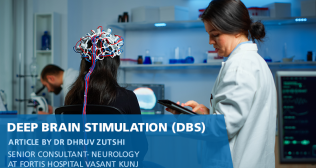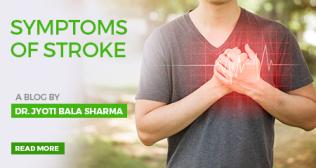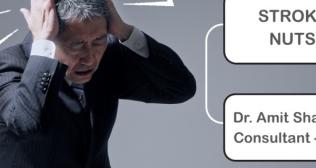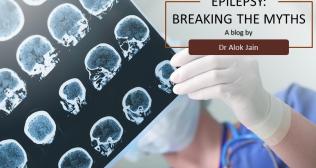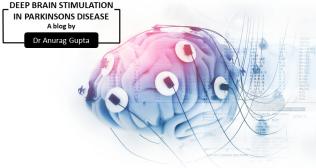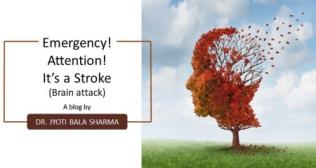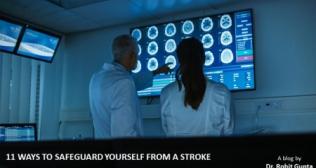
Deep Brain Stimulation: How does it work? Know the benefits and risks of the procedure
Deep brain stimulation (DBS) is a type of surgical procedure used to treat some neurological conditions that affect movement, such as Parkinson’s disease (PD), epilepsy, essential tremor, and dystonia. Doctors at Fortis Hospital, Mulund, have been performing DBS with great precision and accuracy, using the latest techniques. Our specialists are experts in programming and troubleshooting the DBS system, ensuring optimal outcomes.
This article provides an overview of deep brain stimulation, how it works, why it’s done, and the benefits and potential risks involved in the procedure.
What is deep brain stimulation?
Deep brain stimulation is a neurosurgical procedure that uses a mild electrical current delivered to specific parts of the brain responsible for controlling movement. This procedure involves the surgeon implanting one or more small electrodes, also called leads, in the target site of the brain to deliver electrical signals generated by a pacemaker-like device usually placed beneath the collarbone.
The DBS system is made up of three parts:
- A lead – a thin, insulated wire with an electrode, implanted in the target area of the brain, causing tremor and other symptoms.
- A pulse generator – a programmable device, also known as stimulator battery, is placed under the skin in the chest. This internal pulse generator (IPG) produces and sends electrical pulses through the electrodes implanted in the brain to improve symptoms.
- An extension wire – an insulated wire that travels under the skin, connecting the electrodes to the electrical generator device.
How do doctors perform deep brain stimulation surgery?
Most people who need DBS require two separate surgeries to implant the electrodes and pulse generator, although some cases may be done in a single procedure.
The first procedure involves the surgeon implanting the leads or electrodes into the targeted site of the brain, using imaging such as CT or MRI. Patients may be given a local or general anaesthesia for this procedure.
In the second procedure, which may take place days or weeks after the leads are placed, patients will be given general anaesthesia to put them to sleep. The surgeon inserts the pulse generator under the skin just below the collarbone. This battery-run device, which creates and sends electrical pulses to the brain, is connected to the ends of the electrodes with the extension wire passed underneath the skin.
How does deep brain stimulation work?
Deep brain stimulation works by disrupting the abnormal electrical signals in a specific area of the brain that cause tremors, stiffness, and other symptoms of neurological conditions like Parkinson’s disease and epilepsy. The procedure is considered safe as it does not damage healthy brain tissue or nerve cells, although patients can experience some adverse effects from the treatment.
Deep brain stimulation is an ongoing treatment, where the settings on the DBS device will need to be adjusted by a healthcare provider from time to time, based on an individual’s unique symptoms, to achieve optimal results. This adjustment of the pulse generator enables doctors to strike a perfect balance between better symptom management and limiting side effects.
What conditions does deep brain stimulation treat?
Doctors use deep brain stimulation to improve symptoms of some neurological or psychiatric conditions, including:
- Parkinson’s disease
- Epilepsy
- Essential tremor
- Dystonia
- Tourette syndrome
- Obsessive-compulsive disorder
Research is being carried out to see if this treatment also works for other conditions, such as Alzheimer’s disease, multiple sclerosis, chronic pain, addiction, eating disorders, anxiety, depression, schizophrenia, etc.
What kind of patients can benefit from deep brain stimulation and who should not have it?
Deep brain stimulation may be a good option for people with medication-resistant movement disorders and certain neurological and psychiatric conditions experiencing widespread symptoms. This revolutionary treatment is typically recommended only when medications cannot effectively control the symptoms or cause side effects that interfere with a person’s quality of life.
Not all people living with Parkinson’s disease or other movement disorders can opt for DBS surgery. For instance, elderly patients and people with severe dementia, uncontrolled psychiatric conditions, or additional illnesses may not be good candidates for the procedure.
Patients considering DBS must discuss with a neurologist who specialises in movement disorders to determine if they are a good fit for this type of treatment.
What are the benefits and risks of deep brain stimulation?
DBD offers several benefits, such as:
- It can help better control tremor and other symptoms in people with Parkinson’s disease with lower medication dosages and reduced side effects.
- It can help improve a person’s quality of life and overall well-being.
- It delivers adjustable stimulation for therapeutic effect.
- It is a reversible procedure – meaning patients can remove the device in a follow-up surgery if the treatment doesn’t work or causes severe side effects.
Like any surgical procedure, DBS comes with some risks. Although rare, potential risks and complications of DBS surgery may include:
- Bleeding
- Swelling
- Infection
- Stroke
- Seizure
Deep brain stimulation surgery can effectively help manage symptoms and enhance quality of life in carefully selected patients with certain conditions that affect the brain and mental health, such as Parkinson’s disease. However, it may be noted that the procedure does not cure a neurological condition or stop the disease’s progression.







